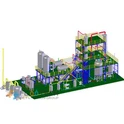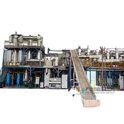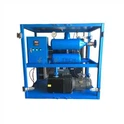The significance, background and test methods of interfacial tension
In a broad sense, interfacial tension is defined as the force that must be expended to increase the size of the interface between two adjacent phases that are not fully mixed. In a narrower sense, the term relates to liquid/liquid and liquid/solid phase boundaries, while for liquid/gas interfaces we refer to surface tension and for solid/gas interfaces we refer to the free energy of the solid surface.
background
As a measure of work per unit area or force per wetted length, interfacial tension has units of N/m or mN/m and is represented by the symbols σ or γ.
At a phase boundary, the sum of the interactions with the molecules in the same phase is greater than the sum of the interactions with the molecules in the other phase. Therefore, the molecules at the interface have fewer attractive interaction partners than in the bulk phase. Therefore, the phases form the smallest possible interface without the action of external forces. Something has to be done to increase the size of the interface.
The interfacial tension caused by the directional adsorption of surfactants at the interface of two immiscible liquids is significantly lower than the surface tension of the two liquids. Systems showing interfacial tension usually consist of water, oil, surfactants or surfactant mixtures and salts. Usually, the interfacial tension value of 10-2~10-1mN/m is called low interfacial tension. The interfacial tension value below 10-3mN/m is called ultra-low interfacial tension.
Bulk Phase and Molecular Environment at Interfaces
As with surface tension, there is a distinction between static interfacial tension (measured at equilibrium at a mechanically unchanged interface) and dynamic interfacial tension (measured when the interface is changing).
significance
Interfacial tension plays an important role in many processes and phenomena where different phases come into contact with each other:
Emulsions and emulsification: Interfacial tension affects emulsification and the tendency for phase separation.
Oil displacement (e.g. tertiary crude oil production): The organic phase can be displaced after oil displacement with water if the interfacial tension is reduced by surfactants.
Quality testing of hydrophobic liquids: The aging of hydrophobic liquids is often closely related to a decrease in the interfacial tension with water. The measurement of the interfacial tension is an important quality test in this case, for example transformer oils.
In the case of solid-liquid phase boundaries, interfacial tension affects the long-term stability of interfacial contacts, for example during gluing and coating processes.
Measurement method
Liquid-Liquid Interface:
Ring method according to Du Noüy: In this method the force acting on a wetted ring due to the tension of a thin layer of liquid drawn out when the ring is moved from one phase to the other is measured.
Plate method according to Wilhelmy: In this method the forces acting on a wettable plate vertically immersed in the lower phase are measured.
Rod method: Same as the plate method, but uses a cylindrical rod with a smaller wetted length to measure smaller liquid volumes.
Drop volume method: measures the volume of a drop of liquid when it breaks away from another liquid in a vertical capillary tube.
Spinning drop method: A horizontal capillary filled with bulk phase and droplet phase is set in rotation. The diameter of the droplet, elongated by centrifugal force, is related to the interfacial tension.
Pendant drop method: In a bulk liquid phase, the shape of the drop on the needle is determined by factors such as the interfacial tension. The interfacial tension can be determined from the drop image using drop shape analysis.
Liquid-solid interface:
Contact Angle Measurement: In addition to its surface free energy, the interfacial tension of a solid with a particular liquid can also be calculated from the contact angles of various liquids with the solid.
Series FT-ZL Automatic Interfacial Tension Tester

If you are interested, please feel free to contact us








